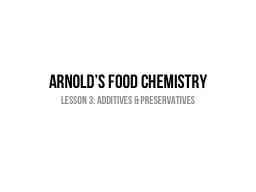

Lesson 3 Additives amp Preservatives Intentional Additives Chemicals that are intentionally introduced to foods to aid in processing Their use is strictly regulated by national and international laws ID: 496271
Download Presentation The PPT/PDF document "Arnold’s Food Chemistry" is the property of its rightful owner. Permission is granted to download and print the materials on this web site for personal, non-commercial use only, and to display it on your personal computer provided you do not modify the materials and that you retain all copyright notices contained in the materials. By downloading content from our website, you accept the terms of this agreement.
Slide1
Arnold’s Food Chemistry
Lesson 3: Additives & PreservativesSlide2
Intentional Additives
Chemicals that are intentionally introduced to foods to aid in processing
Their use is strictly regulated by national and international laws
to act as preservatives
or to improve the quality of the food – are called intentional additivesSlide3
Intentional Additives (cont.)
The purpose of food additives
To improve or maintain nutritional value
To enhance quality
To reduce wastage
To enhance consumer acceptability
To improve keeping quality
To make the food more readily available
To facilitate preparation of the foodSlide4
Intentional Additives (cont.)
The use of food additives is in effect a food processing method
In many food processing techniques, the use of additives is an integral part of the method, as is smoking, heating, and fermentingSlide5
Intentional Additives (cont.)
In the following situations additives should
not
be used:
To disguise faulty or inferior processes
To conceal damage, spoilage, or other inferiority
To deceive the consumer
If use entail substantial reduction in important nutrients
If the desired effect can be obtained by economical, good manufacturing practices
In amount greater than the minimum necessary to achieve the desired effectsSlide6
Intentional Additives (cont.)
There are several ways of classifying intentional food additives
One such method lists the following three main types of
additives
1.
complex substances such as proteins or starches that are extracted form other foods
For example: the use of
caseinate
in sausages and prepared meatsSlide7
Intentional Additives (cont.)
2.
naturally
occurring, well-defined chemical compounds such as salt, phosphates, acetic acid, and ascorbic acid
3.
substances
produced by synthesis, which may or may not occur in nature, such as coal tar dyes, synthetic B-carotene, antioxidants, preservatives, and emulsifiers Slide8
Preservatives
Preservatives or antimicrobial agents play an important role in today’s supply of safe and stable foods
Increasing demand for convenience foods and reasonably long shelf life of processed foods make the use of chemical food preservatives imperative
Some of the commonly used preservatives – such as sulfites, nitrate, and salt – have been used for centuries in processed meats and wineSlide9
Preservatives (cont.)
The choice of antimicrobial agent has to be based on a knowledge of the
antimicrobial spectrum of the preservative
the chemical and physical properties of both food and preservative
the conditions of storage and handling,
the assurance of a high initial quality of the food to be preserved